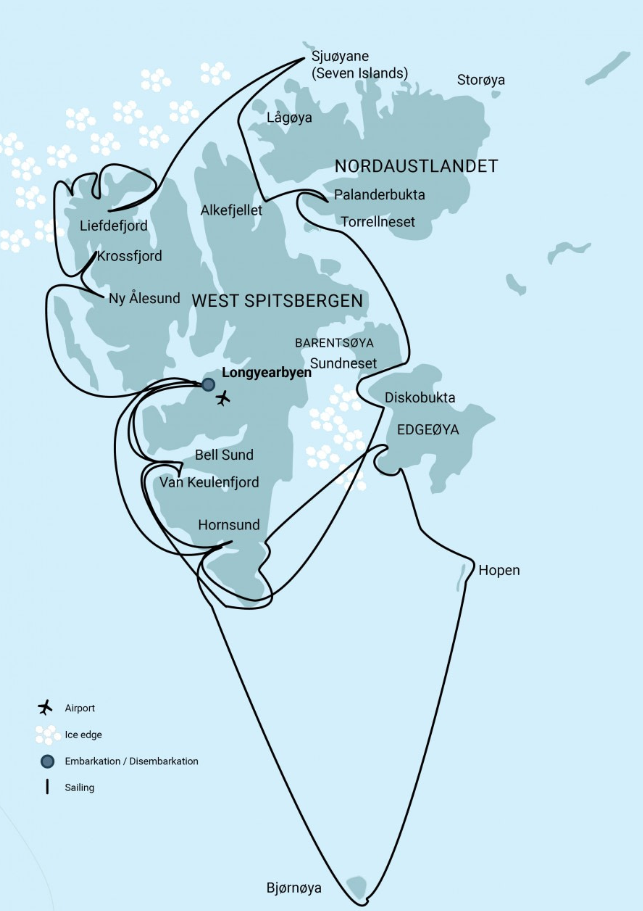
This fantastic combination cruise lets you enjoy not only a circumnavigation of Spitsbergen but also an extended voyage into Svalbard's scenically stunning eastern shores - including Bear Island, where colonies of exotic Arctic birds nest above dazzling spans of sea ice.
- Wildlife Encounters: This exploratory cruise around the east shores of Spitsbergen offers incredible opportunities to witness a variety of Arctic wildlife, including minke whales, Arctic foxes, and the majestic polar bears. The chance to see the King of the Arctic in its natural habitat is a highlight of this journey, making it a dream come true for wildlife enthusiasts.
- Bear Island Bird Watching: Bear Island, as the name suggests, is a paradise for bird lovers. The island is home to large colonies of Brünnich’s guillemots, kittiwakes, and fulmars that breed on shoreline cliffs. The sight of these birds, set against the backdrop of dazzling drift ice, provides a stunning and unique bird-watching experience.
- Scenic Cruising: The cruise takes you through some of the most rugged and visually captivating landscapes in the Arctic region. Sailing into Liefdefjorden, you'll have the opportunity to cruise near the face of the impressive Monaco Glacier. The glacier front is not only a breathtaking sight but also a favored feeding spot for thousands of Kittiwakes, with occasional Polar Bear sightings on the glacier, adding to the excitement.
Availability is always subject to confirmation. Please check with us before booking flights
There are no future departures for this trip at this stage.
Ortelius

| Length | 91 metres |
|---|
The ice-strengthened vessel “Ortelius” is an excellent vessel for Polar expedition cruises in the Arctic and Antarctica, providing possibilities to adventure remote locations such as the Ross Sea.
The vessel has the highest ice-class notation (UL1 equivalent to 1A) and is therefore very suitable to navigate in solid one-year sea ice and loose multi-year pack ice. “Ortelius” is a great expedition vessel for 100 passengers with lots of open-deck spaces and a very large bridge which is accessible to the passengers. The vessel is manned by 34 highly experienced crew, 15 international catering staff, including stewardesses, 6 expedition staff (1 expedition leader and 5 guides/lecturers) and 1 doctor.
”Ortelius” offers a comfortable hotel standard, with two restaurants, a bar/lecture room and a sauna. Ortelius' voyages are primarily developed to offer our passengers a quality exploratory wildlife program, trying to spend as much time ashore as possible. As the number of passengers is limited to approximately 100 on the “Ortelius”, flexibility assures maximum wildlife opportunities.
Passengers on a typical voyage range from in their 30s to their 80s, with the majority usually between 45 ― 65. Our expeditions attract independent travelers from around the globe who are characterized by a strong interest in exploring remote regions. The camaraderie that develops on board is an important part of the Oceanwide experience, and many passenger groups include several nationalities.
“Ortelius” was built in Gdynia, Poland in 1989, was named “Marina Svetaeva”, and served as a special purpose vessel for the Russian Academy of Science. The vessel is re-flagged and renamed “Ortelius”. Ortelius was a Dutch / Flemish cartographer. Abraham Ortelius (1527 – 1598) published the first modern world atlas, the Theatrum Orbis Terrarum or Theatre of the World in 1570. At that time, the atlas was the most expensive book ever printed.
What to Wear
In keeping with the spirit of expedition, dress on board is informal. Bring casual and comfortable clothing for all activities, and keep in mind that much of the scenery can be appreciated from deck ― which can be slippery. Bring sturdy shoes with no-slip soles, and make sure your parka is never far away in case one of our crew shouts “Whales!” over the loudspeaker and you have to dash outside in a moment’s notice. Opt for layers, as it is comfortably warm aboard the ship though often cold on deck.
Electric Current
The electrical supply aboard ship is 220v, 60Hz. Electrical outlets are standard European with two thick round pins, so some passengers may need a 220v/110v converter.
Tipping
The customary gratuity to the ship’s service personnel is made as a blanket contribution at the end of the voyage and is divided among the crew. Tipping is a personal matter, and the amount you wish to give is at your sole discretion. As a generally accepted guideline, we suggest 8 ― 10 euros per passenger per day. It is better for the crew if you give cash.
Smoking Policy
Ortelius has a non-smoking policy inside, though you can smoke in certain designated areas. We ask that you please respect the wishes of non-smokers and please never throw your cigarette ends overboard or anywhere except the designated bin.
Deck plans are for illustrative purposes only – The actual ship and cabin layout may differ.



